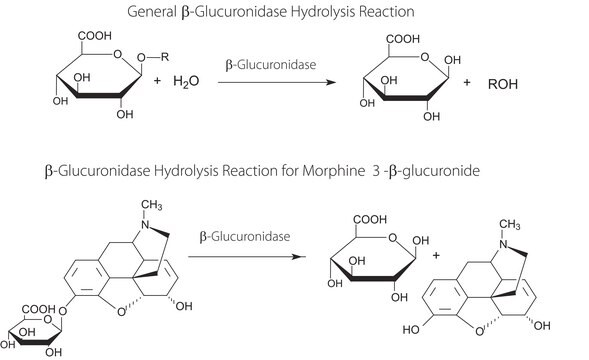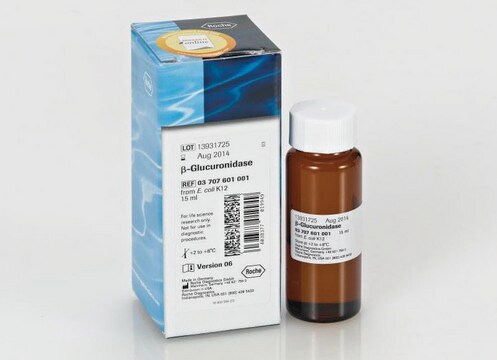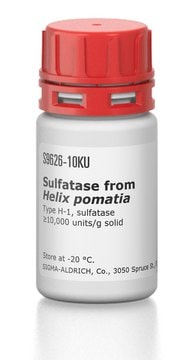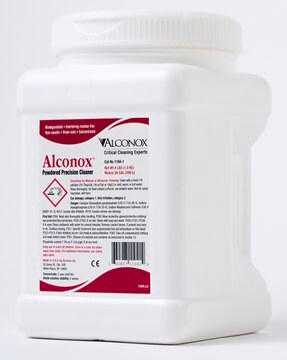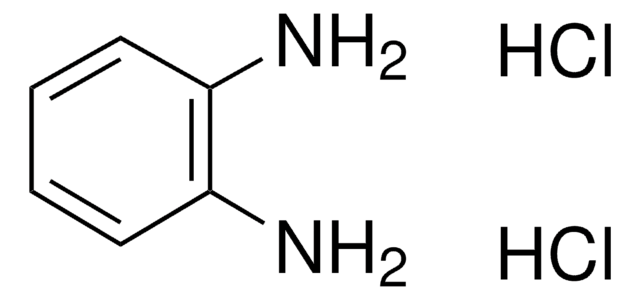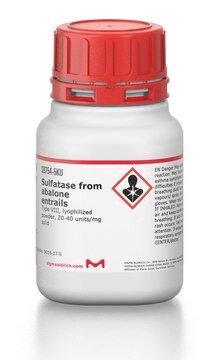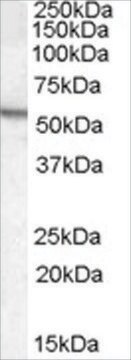Wszystkie zdjęcia(1)
Kluczowe dokumenty
BGALA-RO
Roche
β-Glucuronidase/Arylsulfatase
from Helix pomatia
Synonim(y):
arylsulfatase/β-glucuronidase, sulfatase/β-glucuronidase
Zaloguj sięWyświetlanie cen organizacyjnych i kontraktowych
About This Item
Kod UNSPSC:
12352204
Polecane produkty
pochodzenie biologiczne
animal (Helix pomatia)
Poziom jakości
Formularz
solution
opakowanie
pkg of 10 mL (10127698001)
pkg of 2 mL (10127060001)
producent / nazwa handlowa
Roche
metody
ELISA: suitable
kolor
colorless to brown
optymalne pH
4.5-5.0
rozpuszczalność
water: miscible
Zastosowanie
life science and biopharma
sample preparation
temp. przechowywania
2-8°C
Opis ogólny
β-Glucuronidase/Arylsulfatase from Helix pomatiais is the most widely used enzyme preparation containing sulfatase activity and has a very broad specificity. It is a crude mixture of enzymes and the preparation does not involve any kind of chromatographic separation. This preparation contains both glucuronidase and sulfatase activity. Enzymatic hydrolysis prior to detection is essential for achieving high sensitivity during analysis. After hydrolysis, the sample may be analyzed by mass spectroscopy, gas chromatography, HPLC, or immunoassays. For doping analysis, the sulfatase activity in addition to the glucuronidase activity is essential for the detection of all drug conjugates present in the sample. β-Glucuronidase/Arylsulfatase is also used for the enzymatic hydrolysis of glucuronides and sulfate esters in biological fluids and primarily urine.
Specyficzność
β-Glucuronidase/Arylsulfatase shows a broad specificity for many kinds of β-glucuronides and sulfate esters.
Specificity of β-Glucuronidase:
The glycosides that β-D-glucuronic acid forms with a variety of compounds containing hydroxyl groups hydrolyze readily in the presence of β-glucuronidase.
β-Glucuronidase is highly specific for the carbohydrate part: neither α-glucosides nor β-glucosiduronic acids are hydrolyzed. However, the nature of the residue linked to the β-glucuronic acid residue is hardly important at all.
Specific activity: 5.5 U/ml at +38°C with phenolphthalein-β-glucuronide as the substrate (4.5 U/ml at +25°C with 4-nitro-phenyl-β-D-glucuronide as the substrate = 100,000 Fishman units/ml at +38°C with phenolphthalein-β-glucuronide as the substrate). 1 Fishman unit releases 1 μg phenolphthalein from phenolphthalein-β-glucuronide in 1 hour at +38°C.
Specificity of Acrylsulfatase:
Sulfate esters of many phenols are hydrolysed in the presence of arylsulfatase. Examples are steroid sulfates such as estronesulfate, 4-nitrophenyl hydrogen sulfate (Km = 1.8 mM, pH 7.3), 4-nitro-pyrocatechol 2-sulfate (Km = 1.25 mM, pH 7.5), and phenolphthalein disulfate.
Specific activity: 2.6 U/ml at +38°C with phenolphthalein disulfate as the substrate (14 U/ml at +25°C with 4-nitrophenyl sulfate as the substrate = 800,000 Roy units/ml at +38°C with 2-hydroxy-5-nitrophenyl sulfate as the substrate). 1 Roy unit releases 1 μg 2-hydroxy-5-nitrophenyl sulfate in 1 hour at +38°C.
Specificity of β-Glucuronidase:
The glycosides that β-D-glucuronic acid forms with a variety of compounds containing hydroxyl groups hydrolyze readily in the presence of β-glucuronidase.
- Such compounds include steroids, such as estriol (Km = 0.42 mM, pH 4.5), androsterone, pregnanediol, tetrahydrocortisone,
- phenols, such as phenolphthalein (Km = 0.39 mM), 4-nitro-phenol, 4-methylumbelliferone,
- drugs such as chloramphenicol and tetrahydrocannabinols,
- and metabolites such as thyroxine and bilirubin.
β-Glucuronidase is highly specific for the carbohydrate part: neither α-glucosides nor β-glucosiduronic acids are hydrolyzed. However, the nature of the residue linked to the β-glucuronic acid residue is hardly important at all.
Specific activity: 5.5 U/ml at +38°C with phenolphthalein-β-glucuronide as the substrate (4.5 U/ml at +25°C with 4-nitro-phenyl-β-D-glucuronide as the substrate = 100,000 Fishman units/ml at +38°C with phenolphthalein-β-glucuronide as the substrate). 1 Fishman unit releases 1 μg phenolphthalein from phenolphthalein-β-glucuronide in 1 hour at +38°C.
Specificity of Acrylsulfatase:
Sulfate esters of many phenols are hydrolysed in the presence of arylsulfatase. Examples are steroid sulfates such as estronesulfate, 4-nitrophenyl hydrogen sulfate (Km = 1.8 mM, pH 7.3), 4-nitro-pyrocatechol 2-sulfate (Km = 1.25 mM, pH 7.5), and phenolphthalein disulfate.
Specific activity: 2.6 U/ml at +38°C with phenolphthalein disulfate as the substrate (14 U/ml at +25°C with 4-nitrophenyl sulfate as the substrate = 800,000 Roy units/ml at +38°C with 2-hydroxy-5-nitrophenyl sulfate as the substrate). 1 Roy unit releases 1 μg 2-hydroxy-5-nitrophenyl sulfate in 1 hour at +38°C.
Specificity of β-Glucuronidase:
The glycosides that β-D-glucuronic acid forms with a variety of compounds containing hydroxyl groups hydrolyze readily in the presence of β-glucuronidase.
β-Glucuronidase is highly specific for the carbohydrate part: neither α-glucosides nor β-glucosiduronic acids are hydrolyzed. However, the nature of the residue linked to the β-glucuronic acid residue is hardly important at all.
Specificity of Acrylsulfatase:
Sulfate esters of many phenols are hydrolysed in the presence of arylsulfatase. Examples are steroid sulfates such as estronesulfate, 4-nitrophenyl hydrogen sulfate (Km = 1.8 mM, pH 7.3), 4-nitro-pyrocatechol 2-sulfate (Km = 1.25 mM, pH 7.5), and phenolphthalein disulfate.
The glycosides that β-D-glucuronic acid forms with a variety of compounds containing hydroxyl groups hydrolyze readily in the presence of β-glucuronidase.
- Such compounds include steroids, such as estriol (Km = 0.42 mM, pH 4.5), androsterone, pregnanediol, tetrahydrocortisone,
- phenols, such as phenolphthalein (Km = 0.39 mM), 4-nitro-phenol, 4-methylumbelliferone,
- drugs such as chloramphenicol and tetrahydrocannabinols,
- and metabolites such as thyroxine and bilirubin.
β-Glucuronidase is highly specific for the carbohydrate part: neither α-glucosides nor β-glucosiduronic acids are hydrolyzed. However, the nature of the residue linked to the β-glucuronic acid residue is hardly important at all.
Specificity of Acrylsulfatase:
Sulfate esters of many phenols are hydrolysed in the presence of arylsulfatase. Examples are steroid sulfates such as estronesulfate, 4-nitrophenyl hydrogen sulfate (Km = 1.8 mM, pH 7.3), 4-nitro-pyrocatechol 2-sulfate (Km = 1.25 mM, pH 7.5), and phenolphthalein disulfate.
Zastosowanie
β-Glucuronidase/Arylsulfatase has been used extensively in research and analytic laboratories for the simultaneous enzymatic hydrolysis of steroid β-glucuronides and sulfate esters. The enzyme is used during sample preparation to cleave off glucuronides and sulfate esters prior to GC-MS, HPLC, immunoassays, or other analytical methods, including doping analysis and hydrolysis of steroid conjugates (glucuronides) and sulfate esters in urine and other body fluids.
Cechy i korzyści
- Deconjugate and detect both glucuronides and sulfate esters.
- Quickly screen for steroids, benzodiazepines, cannabinoids, opioids, and other drugs.
Komponenty
EC 3.1.6.1 & 3.2.1.31
Zasada
Glucuronidation is one of the basic principles of metabolism. Most substances presented to the human body undergo metabolic processing that includes conjugation with glucuronic acid by UDP-glucuronosyltransferases (UGTs). This enzyme catalyzes the transfer of a glucuronyl group to many biological and pharmacologically active endogenous and exogenous molecules. Glucuronide is in general more soluble, less toxic, and more easily excreted by the human body compared to the original molecule.
In addition, sulfation of the drug or chemical substance by sulfotransferases in the human body may occur. Sulfation in general, is less predictable than glucuronidation since many isoenzymes of sulfotransferases exist, and there are individual differences in the ratio of glucuronidation versus sulfation of the substance.
In addition, sulfation of the drug or chemical substance by sulfotransferases in the human body may occur. Sulfation in general, is less predictable than glucuronidation since many isoenzymes of sulfotransferases exist, and there are individual differences in the ratio of glucuronidation versus sulfation of the substance.
Definicja jednostki
Glucuronidase:
Standard unit
The standard unit of β-glucuronidase activity is the enzyme activity that increases the rate of release of 4-nitrophenol from 4-nitrophenyl β-D-glucosiduronic acid at a temperature of +25 °C and pH 4.5 by 1 μM.
Phenolphthalein unit
The phenolphthalein unit of β-glucuronidase activity is the enzyme activity that increases the rate of release of phenolphthalein from phenolphthalein β-D-glucosiduronic acid at a temperature of +38 °C by 1 μM.
Approx. 4.5 standard units are equivalent to 5.5 phenolphthalein units.
Fishman unit
The Fishman unit of β-glucuronidase activity is the enzyme activity that increases the rate of release of phenolphthalein from phenolphthalein β-D-glucosiduronic acid at a temperature of +38 °C by 1 μg.
Approx. 1 standard unit is equivalent to 22,000 Fishman units (1 phenolphthalein unit is equivalent to 19,000 Fishman units).
Arylsulfatase:
Standard unit
The standard unit of arylsulfatase activity is the enzyme activity that increases the rate of release of 4-nitrophenol from 4-nitrophenyl sulfate at a temperature of +25 °C and pH 6.2 by 1 μM.
Phenolphthalein unit
The phenolphthalein unit of arylsulfatase activity is the enzyme activity that increases the rate of release of phenolphthalein from phenolphthalein disulfate at a temperature of +38 °C and pH 6.2 by 1 μM.
Approx. 5.4 standard units are equivalent to 1 phenolphthalein unit.
Roy unit
The Roy unit of arylsulfatase activity is the enzyme activity that increases the rate of release of 4-nitropyrocatechol from 2-hydroxy-5-nitrophenyl hydrogen sulfate (4-nitropyrocatechol 2-sulfate) at a temperature of +38 °C and pH 6.2 by 1 μg.
Approx. 1 standard unit is equivalent to 57,000 Roy units (1 phenolphthalein unit is equivalent to 308,000 Roy units).
Standard unit
The standard unit of β-glucuronidase activity is the enzyme activity that increases the rate of release of 4-nitrophenol from 4-nitrophenyl β-D-glucosiduronic acid at a temperature of +25 °C and pH 4.5 by 1 μM.
Phenolphthalein unit
The phenolphthalein unit of β-glucuronidase activity is the enzyme activity that increases the rate of release of phenolphthalein from phenolphthalein β-D-glucosiduronic acid at a temperature of +38 °C by 1 μM.
Approx. 4.5 standard units are equivalent to 5.5 phenolphthalein units.
Fishman unit
The Fishman unit of β-glucuronidase activity is the enzyme activity that increases the rate of release of phenolphthalein from phenolphthalein β-D-glucosiduronic acid at a temperature of +38 °C by 1 μg.
Approx. 1 standard unit is equivalent to 22,000 Fishman units (1 phenolphthalein unit is equivalent to 19,000 Fishman units).
Arylsulfatase:
Standard unit
The standard unit of arylsulfatase activity is the enzyme activity that increases the rate of release of 4-nitrophenol from 4-nitrophenyl sulfate at a temperature of +25 °C and pH 6.2 by 1 μM.
Phenolphthalein unit
The phenolphthalein unit of arylsulfatase activity is the enzyme activity that increases the rate of release of phenolphthalein from phenolphthalein disulfate at a temperature of +38 °C and pH 6.2 by 1 μM.
Approx. 5.4 standard units are equivalent to 1 phenolphthalein unit.
Roy unit
The Roy unit of arylsulfatase activity is the enzyme activity that increases the rate of release of 4-nitropyrocatechol from 2-hydroxy-5-nitrophenyl hydrogen sulfate (4-nitropyrocatechol 2-sulfate) at a temperature of +38 °C and pH 6.2 by 1 μg.
Approx. 1 standard unit is equivalent to 57,000 Roy units (1 phenolphthalein unit is equivalent to 308,000 Roy units).
Postać fizyczna
Solution in saline, stabilized
Uwaga dotycząca przygotowania
Working concentration: In many applications the product can be diluted with water immediately before use or employed undiluted.
Note: The present β-glucuronidase/arylsulfatase preparation is very concentrated and must be diluted for some applications. Moreover, in the preparation of protoplasts, the precise concentration to use for a given strain of yeast must be found empirically.
Storage conditions (working solution): Note: Aliquot portions of the diluted preparation may be stored at -15 to -25 °C; they should not be thawed and refrozen more than a time or two, and storage at the lower temperature does not lengthen their life beyond that of the product kept at 2 to 8 °C.
Note: The present β-glucuronidase/arylsulfatase preparation is very concentrated and must be diluted for some applications. Moreover, in the preparation of protoplasts, the precise concentration to use for a given strain of yeast must be found empirically.
Storage conditions (working solution): Note: Aliquot portions of the diluted preparation may be stored at -15 to -25 °C; they should not be thawed and refrozen more than a time or two, and storage at the lower temperature does not lengthen their life beyond that of the product kept at 2 to 8 °C.
Przechowywanie i stabilność
Avoid repeated freezing and thawing (more than 2 times).
Inne uwagi
For life science research only. Not for use in diagnostic procedures.
Ta strona może zawierać tekst przetłumaczony maszynowo.
Kod klasy składowania
12 - Non Combustible Liquids
Klasa zagrożenia wodnego (WGK)
nwg
Temperatura zapłonu (°F)
No data available
Temperatura zapłonu (°C)
No data available
Wybierz jedną z najnowszych wersji:
Masz już ten produkt?
Dokumenty związane z niedawno zakupionymi produktami zostały zamieszczone w Bibliotece dokumentów.
Klienci oglądali również te produkty
K Croes et al.
Journal of chromatography. B, Analytical technologies in the biomedical and life sciences, 877(7), 635-644 (2009-02-13)
A liquid chromatography tandem mass spectrometry (LC/MS(n)) method for the determination of 12 corticosteroids in bovine liver has been optimized and validated in accordance with the European Commission Decision 2002/657/EC. A bovine liver sample was deconjugated with beta-glucuronidase/sulfatase enzyme, extracted
Marc Vermeir et al.
Drug metabolism and disposition: the biological fate of chemicals, 37(4), 809-820 (2009-01-10)
Absorption, metabolism, and excretion of darunavir, an inhibitor of human immunodeficiency virus protease, was studied in eight healthy male subjects after a single oral dose of 400 mg of [(14)C]darunavir given alone (unboosted subjects) or with ritonavir [100 mg b.i.d.
Erika Pfeiffer et al.
Carcinogenesis, 26(12), 2172-2178 (2005-07-30)
Soy food has been associated with a reduced incidence of hormonal cancer in Asian countries, and the soy isoflavones daidzein and genistein are believed to protect against tumors induced by the endogenous hormone 17beta-estradiol (E2). In the present study, we
Nasz zespół naukowców ma doświadczenie we wszystkich obszarach badań, w tym w naukach przyrodniczych, materiałoznawstwie, syntezie chemicznej, chromatografii, analityce i wielu innych dziedzinach.
Skontaktuj się z zespołem ds. pomocy technicznej